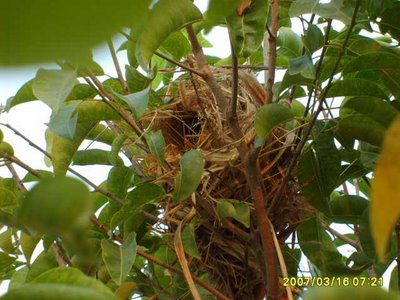Paradise Road


Top. Coppersmith Barbet's nesting hole
Bottom. Scaly-breasted Munia's nest
(March 15th 2007 Mae Hia) Count for the morning 63-7. One new bird today an Asian Paradise Flycatcher bringing the number to 208 spp. This bird heralded its presence with its rasping call and warbling trill. It’s an easy bird to spot with its elongated central tail feathers lashing around behind it as it dodges about catching insects. In this case the tail feathers had only reached about half the size they would eventually be. This male bird loses the two central feathers after breeding and grows them again in time for the next breeding season.
This stretch of road turned out to be very productive this morning. As I was watching the flycatcher a male Junglefowl burst out of the woods behind me, there was a great clattering of wings as it flapped its way over my head, it gave me quite a start. At the same time a pair of Puff-throated Babblers were rooting around on the ground looking for food. In mid-canopy a flock of Striped Tit-Babblers were busy chattering as they moved by in a wave. A mixed flock of Greater Racket-tailed Drongos and Racket-tailed Treepies gathered around and generally showed their curiosity if not displeasure at my presence. Presiding above this activity was a Great Barbet sitting at the top of a tree minding its own business. During all this I hadn’t moved, only to turn around, and stood there for the best part of 30 minutes with binoculars swivelling to all points of the compass. 24 species were spotted from that one spot in those 30 minutes. Sometimes that road can be the quietest of places but sometimes, as this morning, it can really keep one on one’s toes, literally.
(March 16th HTT) Things a little better pollution-wise. We had a light breeze overnight and the smog has lessened to a more bearable degree. I hope the locals don’t take this as a signal to light more fires!
A Coppersmith Barbet seen feeding its young in a hole in a tree. It’s amazing how symmetrical the hole is.
The 5 or 6 Fulvous-breasted Woodpeckers that call the area home seem to have found sounding boards suitable enough to broadcast their messages, they were all at it this morning drumming away like mad.
There was an invasion of Black-collared Starlings, I haven’t seen quite so many at one time before, up to 100 in 3 or 4 trees. Later on a pair of them were seen building a nest and wouldn’t you know it a female Common Koel came to see how they were progressing. They gave her short shrift and sent her packing, for the time being. I hope their work isn’t going to be wasted and they find themselves rearing a monster.
Both the Thick-billed Warbler and the Siberian Rubythroat have become much less the skulkers and more the on-parade types. One Rubythroat came hopping towards me on a grassy track, leading with its blood red throat, and virtually ignored me. The Thick-billed Warblers can be seen in the lower branches to mid-canopy of trees hopping from branch to branch feeding, they do become more daring just before migrating. I’m expecting both species to break out into their delightful , if scratchy, low key warbling songs soon.
(March 17th HTT) The Smog is back with a vengeance this morning, smelling of wood fire mostly – the eyes are back to stinging and the chest aching. The locals obviously did take yesterdays let-up as a signal to start again! The bird count was also low 52-8, seen and heard. Three Purple Sunbird nests watched as parents raced back and forth feeding their young, also two Olive-backed nests with the parent birds doing the same.
Correction to my remark about the Thick-billed Warbler, one seen today at the top of a tree, 60-70 feet high.
Another fruiting tree drew my attention this morning, it was stuffed with birds, Black-collared Starlings, White-vented Mynahs, Common Mynahs, Common Koels, Coppersmith Barbets, Lineated Barbets and a host of different Bulbuls.

1 Comments:
christian louboutin outlet, nike roshe run, ray ban sunglasses, louis vuitton outlet, tory burch outlet, oakley sunglasses, sac longchamp, air jordan pas cher, longchamp pas cher, louboutin outlet, louboutin, gucci outlet, ray ban sunglasses, louis vuitton, ugg boots, jordan shoes, louis vuitton, oakley sunglasses, polo ralph lauren outlet, kate spade outlet, longchamp outlet, replica watches, oakley sunglasses, prada outlet, longchamp outlet, michael kors, polo ralph lauren outlet, ray ban sunglasses, tiffany jewelry, prada handbags, longchamp, chanel handbags, replica watches, nike air max, cheap oakley sunglasses, louis vuitton outlet, nike outlet, louboutin pas cher, tiffany and co, nike air max, louboutin shoes, ralph lauren pas cher, louis vuitton, burberry, oakley sunglasses, nike free, air max, uggs on sale, ugg boots, nike free
Post a Comment
<< Home